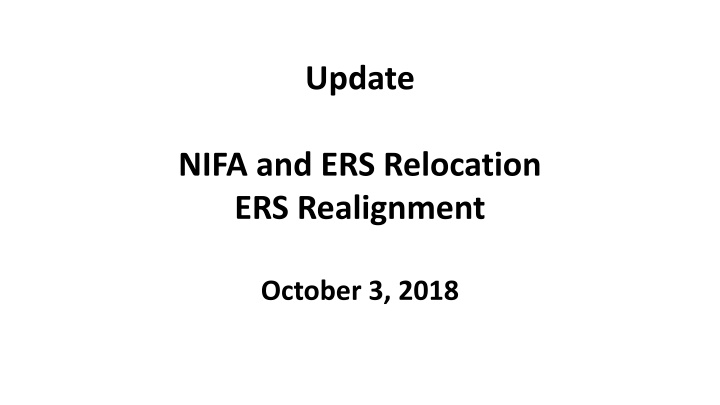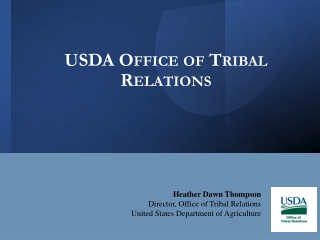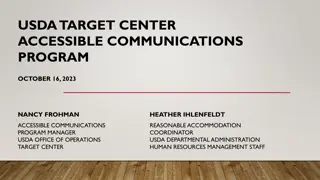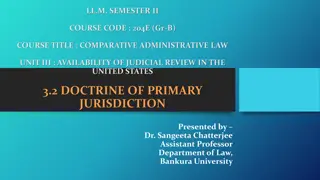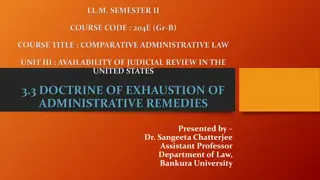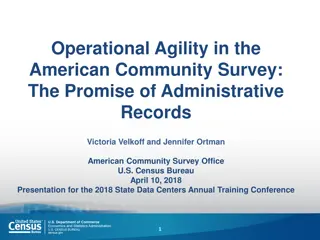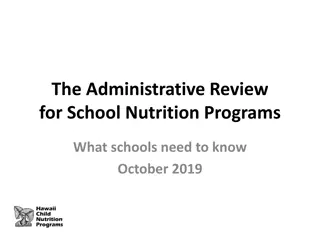USDA Administrative Changes for Enhanced Efficiency
Secretary Perdue announced administrative changes at USDA to improve customer service, strengthen programs, and save taxpayer dollars. The changes include realigning ERS with OCE, relocating NIFA employees, and more. Stakeholders expressed concerns and inquiries regarding the relocation decision.
Download Presentation

Please find below an Image/Link to download the presentation.
The content on the website is provided AS IS for your information and personal use only. It may not be sold, licensed, or shared on other websites without obtaining consent from the author.If you encounter any issues during the download, it is possible that the publisher has removed the file from their server.
You are allowed to download the files provided on this website for personal or commercial use, subject to the condition that they are used lawfully. All files are the property of their respective owners.
The content on the website is provided AS IS for your information and personal use only. It may not be sold, licensed, or shared on other websites without obtaining consent from the author.
E N D
Presentation Transcript
Update NIFA and ERS Relocation ERS Realignment October 3, 2018
Timeline--USDA: August 9: Secretary Perdue announces 3 administrative changes to improve customer service, strengthen offices and programs, and save taxpayer dollars. 1. Realign ERS with Office of the Chief Economist (OCE) 2. Relocate most NIFA employees outside National Capital Region by end of 2019. NIFA Waterfront Centre lease expires in 2019 3. Relocate most ERS employees outside National Capital Region by end of 2019. ERS s lease is some of the most expensive leased space USDA has in the National Capital Region
USDAs Reasons for Relocation: 1. To improve USDA s ability to attract and retain highly qualified staff with training and interests in agriculture, many of whom come from land-grant universities. USDA has experienced significant turnover in these positions, and it has been difficult to recruit employees to the Washington, DC area, particularly given the high cost of living and long commutes. 2. To place these important USDA resources closer to many of stakeholders, most of whom live and work far from the Washington, DC area. 3. To benefit the American taxpayers. There will be significant savings on employment costs and rent, which will allow more employees to be retainedin the long run, even in the face of tightening budgets.
USDAs Reasons for ERS Realignment: 1. Moving ERS back together with OCE under the Office of the Secretary simply makes sense because the two have similar missions. 2. ERS studies and anticipates trends and emerging issues, while OCE advises the Secretary and Congress on the economic implications of policies and programs. 3. These two agencies were aligned once before, and bringing them back together will enhance the effectiveness of economic analysis at USDA.
Timeline--USDA: August 9: Secretary Perdue announces 3 administrative changes to improve customer service, strengthen offices and programs, and save taxpayer dollars. August 15: Federal Register: Notice of Request for Expression of Interest (EOI) for Potential Sites for Headquarters Office Locations Deadline for submission of EOI: September 15, 2018 5 page proposal Potential site for NIFA and/or ERS (one or both agencies) September 12: EOI deadline extended 30 days to October 15, 2018
TimelineStakeholder Input: August 30: Several House Democrats on House Appropriations agriculture subcommittee wrote to USDA expressing concerns o Sanford Bishop, Rosa DeLauro, Chellie Pingree, Mark Pocan September 7: Senate Ag Chairman, Pat Roberts( R-Kan) and ranking member Debbie Stabenow (D-Mich) sent letter to Secretary Purdue with 12 questions September 10: Rep. Eleanor Holmes Norton (D-DC) o Called for joint hearing between Ag Committee and Transportation and Infrastructure panel o Request House Ag Committee to investigate whether USDA has legal authority to relocate NIFA & ERS without Congressional approval o Include provision in FY2019 spending bill to prohibit USDA from carrying out the move September 20: Association of Public Data Users (APDS) webinar o Catherine Woteki, Susan Offutt, Gale Buchanan, Stephen Censky (USDA Deputy Secretary )
Dep. Secretary Censkys Response on APDU Webinar: USDA is considering if NIFA and/or ERS could move outside the beltway to another USDA-owned facility: o George Washington Carver Center (Beltsville, MD; ARS administrators) o Beltsville Agricultural Research Center (Beltsville, MD; ARS scientists) o Other USDA-owned or government-leased facility? USDA is conducting an internal cost-benefit analysis of relocation Asked NIFA and ERS for input on: o What type of work can be done outside DC and what needs to be done in DC? o Who from NIFA and ERS will stay in DC and who will move?
12 Stakeholder Responses to Relocation: 1. Request an independent review of proposed actions (i.e., GAO review) 2. Provide opportunities for stakeholder input o Delay relocation until the research community's concerns are addressed. 3. Conduct cost-benefit analysis o What is the funding impact of a move outside of the National Capital Area, to include employee buyouts and relocation costs? o Need to consider more than just the cost to move USDA what is the cost to USDA partners to travel to another location to meet with just one agency? 4. Who from NIFA or ERS will remain in DC and who will move?
12 Stakeholder Responses to Relocation (continued): 5. What is the evidence that there are recruitment/retention/turnover issues for NIFA or ERS personnel? 6. How will a move impact the ability to recruit, hire, and retain qualified staff? o NIFA and ERS staff that do not relocate leads to a substantial loss of talent and capacity (i.e., institutional memory) 7. Will there be a transparent process to select the new site(s)? 8. Will relationships and opportunities continue to grow with other federal agencies if NIFA is not in Washington, DC? o In recent years, NIFA partnerships with other federal agencies to leverage NIFA funding with joint agency programs/RFAs.
12 Stakeholder Responses to Relocation (continued): 9. Can NIFA be considered to stand on equal footing with its science agency peers, if located outside of Washington, DC? 10. How will the move raise the profile of food/agriculture/natural resources research in Washington, DC? 11. Will the move diminish interest in NIFA s programs? 12. Locating NIFA at or near entities applying for grants may introduce a conflict of interest (real or perceived) and may show favoritism to the state(s) hosting NIFA and/or ERS.
Stakeholder Responses to Re-alignment of ERS: 1. Transferring ERS to the Office of the Chief Economist would be "illegal" because a 1994 law that created the research, education and economics mission area stipulated that ERS should be part of the mission area. 2. ERS could become more vulnerable to political influence and there may be a loss of unbiased research by ERS. 3. Potential for decreased scientific integrity of economic analysis conducted by ERS. 4. What is the Department s plan for ensuring program continuity and issuance of critical reports and research from ERS?
Secretary Perdues Responses to 12 Questions: September 20, 2018 1. Committed to retaining the necessary staff from each Agency in the D.C. area to fulfill these important roles 2. Realigning ERS under OCE and relocating staff from both NIFA and ERS outside of the National Capital Region area will improve stakeholder engagement 3. Long-run viability of both ERS and NIFA will be strengthened even in the face of diminishing budgets by significantly reducing rent and living costs
Secretary Perdues Responses to 12 Questions: September 20, 2018 4) Reviewing multiple options that include USDA-owned space currently available and review of GSA space. 5) Our main monetary savings from a relocation will be realized due to lower staff locality pay adjustments and future facility cost savings in areas outside of the National Capital Region as compared to D.C. 6) ERS and NIFA attrition for permanent employees over the past 5 years (excluding interns) totals 7.88 and 8.62 percent versus USDA attrition for all permanent employees over the past 5 years (excluding interns and Forest Service) totals 6.95 percent for both agencies.
Secretary Perdues Responses to 12 Questions: September 20, 2018 7) Rolling transition of staff along with focused hiring (June December 2019) to fill any vacated essential positions at the new location(s) 8) Timeline: identify the new location(s) by January 2019 and open the new office(s) in the summer of 2019 9) The Secretary retains authority under Reorganization Plan No. 2 of 1953 to reorganize the Department
Secretary Perdues Responses to 12 Questions: September 20, 2018 10)USDA is a science-based Agency, and compliance with all relevant scientific integrity directives is and will continue to be a priority. 11)This is an internal operational decision that we typically do not solicit for public comment. We are actively meeting with stakeholders and welcome feedback as we go forward.
Stay tuned Association of Public Data Users (APDU) webinar: http://apdu.org/2018/09/21/usda-research-relocation-and-reorganization-perspectives-from-former-usda-chief-scientists- and-administrators/ 12 Stakeholder questions: http://www.aplu.org/members/commissions/food-environment-and-renewable-resources/board-on-agriculture- assembly/academic-programs-section/documents/NIFA%20Relocation%20Community%20Questions.pdf Secretary Perdue s response to 12 Stakeholder questions: http://www.aplu.org/members/commissions/food-environment-and-renewable-resources/board-on-agriculture- assembly/perdue_senate_response_september_2018.pdf?_cldee=Z2F0MTBAcHN1LmVkdQ%3d%3d&recipientid=contact- 9b2b70186987e7118113fc15b4286c00-80c157672b1e4b51ac6a483d6fb2b279&esid=2f470fdd-14ca-4190-acf1- eca7682887ec
